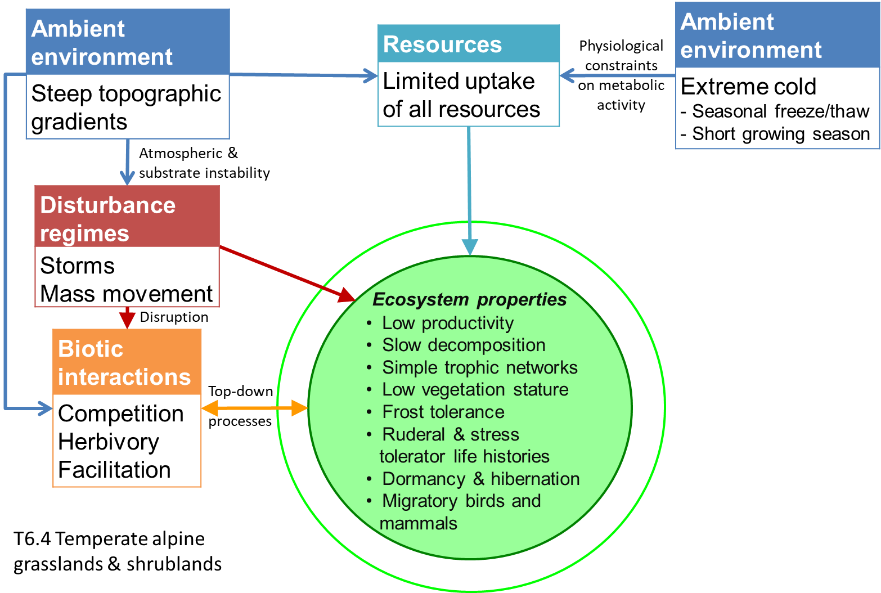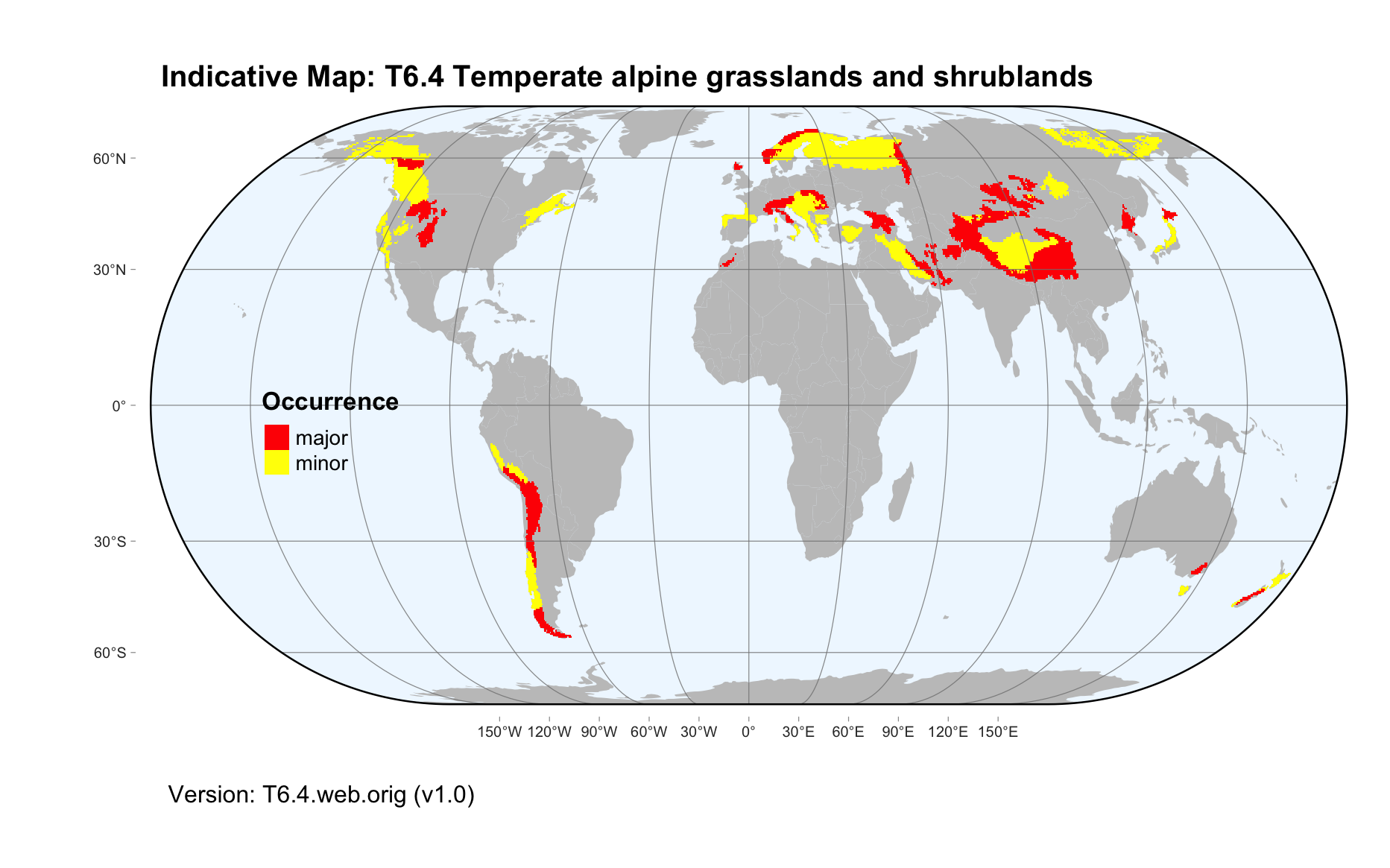Global ecosystem typology
Alternative site for the Global ecosystem typology with additional information for ecosystem profiles and indicative maps.
This site is maintained by jrfep
T6.4 Temperate alpine grasslands and shrublands
Biome: T6. Polar/alpine (cryogenic) biome
Contributors:
(texts)
Temperate alpine grasslands and shrublands occur above the treeline, on temperate and boreal mountains worldwide. Seasonal productivity is limited by cold and snow cover, often with strong winds. Mosses, liverworts, lichens, flowering plants and low shrubs generally form a continuous cover, except where strong winds and dry conditions limit vegetation to sparse lichens and dwarf shrubs. Most fauna is seasonally active during warmer summer months, with insects and vertebrates having adaptations to extreme cold, including hibernation. Many species have restricted distributions, with strong barriers to dispersal between mountains.
Key Features
Mountain systems above the physiological limits of trees, with sparse to continuous cover of herbaceous plants, cryptogams and dwarf shrubs that may be morphologically adaptated to extreme cold..
Overview of distribution
Ttemperate and boreal zones of the Americas, Europe, central Eurasia, west and north Asia, Australia, and New Zealand.
Profile versions
- v1.0 (2020-01-20): DA Keith; F Essl
- v2.0 (2020-05-31): DA Keith; F Essl; KR Young; CH Körner
- v2.01 ():
- v2.1 (2022-04-06): DA Keith; F Essl; KR Young; CH Körner Full profile available at official site
Main references
Selected references for this functional group:
Körner C (2004) Mountain biodiversity: its causes and function Ambio Special Report Number 13. The Royal Colloquium: Mountain Areas: A Global Resource, pp. 11-17. Springer, Berlin DOI:10.4324/9780429342585-1
Körner C (2012) Alpine treelines Springer, Basel. ISBN 978-3-0348-0396-0 DOI:978-3-0348-0396-0
Paulsen J, Körner C (2014) A climate-based model to predict potential treeline position around the globe Alpine Botany 124, 1-12 DOI:10.1007/s00035-014-0124-0
Diagrammatic assembly model

Maps
Maps are indicative of global distribution patterns are not intended to represent fine-scale patterns. The maps show areas of the world containing major (coloured red) or minor occurrences (coloured yellow) of each ecosystem functional group. See general notes on maps.
There are 2 alternative versions of the indicative map for this functional group, please compare description and sources below.
T6.4.IM.orig_v1.0
Datasets
- Resolve-Ecoregions-2017
Map references
Dinerstein E, Olson D, Joshi A, Vynne C, Burgess ND, Wikramanayake E, Hahn N, Palminteri S, Hedao P, Noss R, Hansen M, Locke H, Ellis EE, Jones B, Barber CV, Hayes R, Kormos C, Martin V, Crist E, Sechrest W, Price L, Baillie JEM, Weeden D, Suckling K, Davis C, Sizer N, Moore R, Thau D, Birch T, Potapov P, Turubanova S, Tyukavina A, de Souza N, Pintea L, Brito JC, Llewellyn Barnekow Lillesø JP, van Breugel P, Graudal L, Voge M, Al-Shammari KF, Saleem M (2017) An Ecoregion-Based Approach to Protecting Half the Terrestrial Realm, BioScience 67: 534–545. DOI:10.1093/biosci/bix014. Data-set available on-line
T6.4.web.orig_v1.0

Datasets
- Resolve-Ecoregions-2017
Map references
Dinerstein E, Olson D, Joshi A, Vynne C, Burgess ND, Wikramanayake E, Hahn N, Palminteri S, Hedao P, Noss R, Hansen M, Locke H, Ellis EE, Jones B, Barber CV, Hayes R, Kormos C, Martin V, Crist E, Sechrest W, Price L, Baillie JEM, Weeden D, Suckling K, Davis C, Sizer N, Moore R, Thau D, Birch T, Potapov P, Turubanova S, Tyukavina A, de Souza N, Pintea L, Brito JC, Llewellyn Barnekow Lillesø JP, van Breugel P, Graudal L, Voge M, Al-Shammari KF, Saleem M (2017) An Ecoregion-Based Approach to Protecting Half the Terrestrial Realm, BioScience 67: 534–545. DOI:10.1093/biosci/bix014. Data-set available on-line
Check: the Glossary / Profile structure / the public document